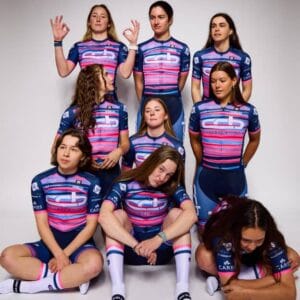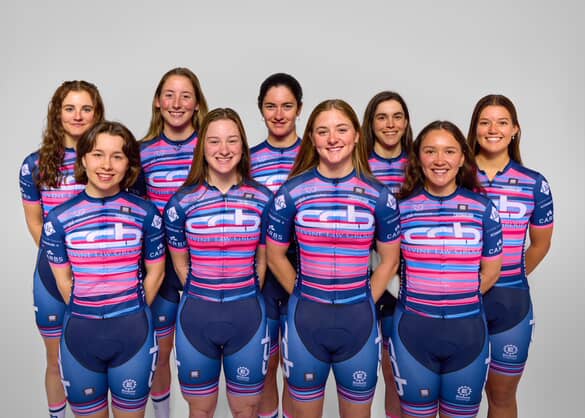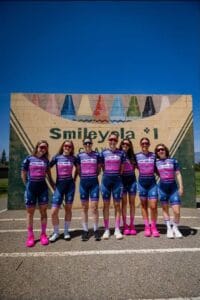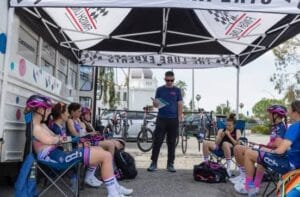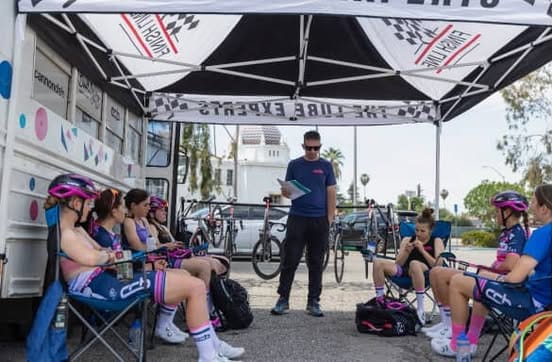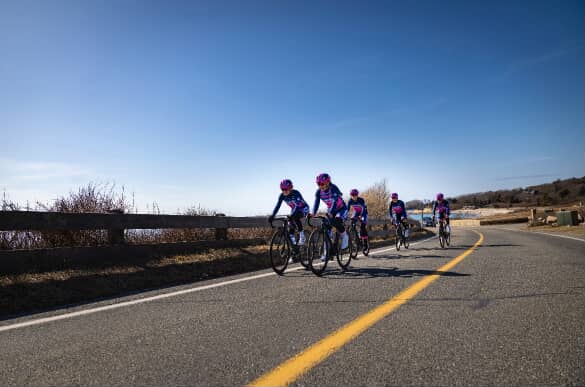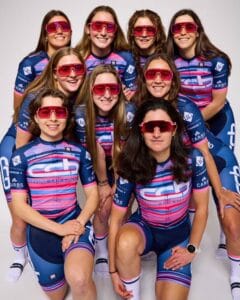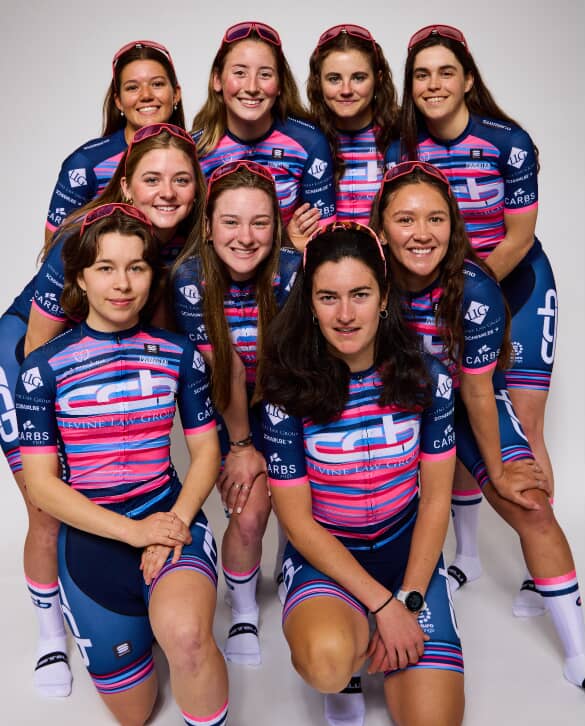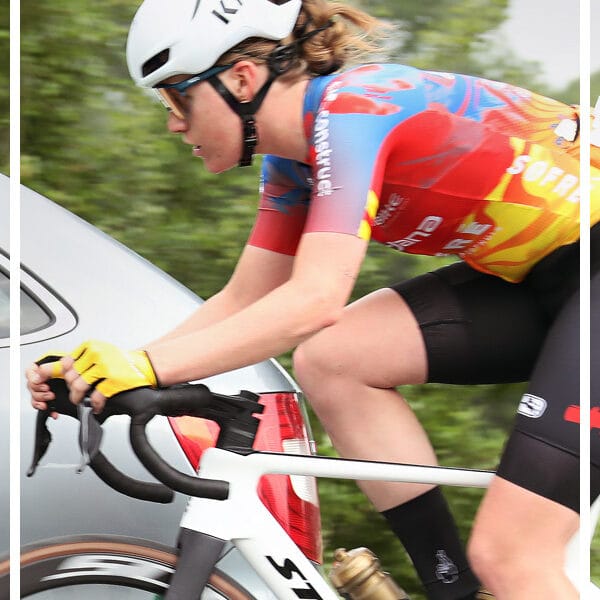Beyond the podium: how Tim Mitchell and CCB are redefining success in women’s cycling
In the ever-evolving world of professional cycling, the gap between the World Tour and development-level teams continues to widen. The sport’s elite tier thrives on abundant resources, cutting-edge technology, and media spectacle… where a custom-painted bike or sponsor-driven aesthetic can sometimes eclipse the deeper purpose of athlete development. Yet beyond the glamour, a quieter but equally vital mission unfolds: creating a safe, balanced environment where young riders can grow… not only as athletes, but as people.
Few understand that balance better than Tim Mitchell, co-director – along with Lauren LeClaire – of CCB p/b Levine Law Group, a U.S.-based development team that has made “education through athletics” its cornerstone. In a cycling landscape often obsessed with instant results, CCB takes a refreshingly long-term view… prioritizing process over podiums and balance over burnout. In our conversation, Mitchell spoke about the values that define CCB’s philosophy: why success begins with patience, how equity matters more than equality, and why remembering that “cycling is just one part of life” might be the most important lesson of all.
Balancing athletics and academics
Tim, before we dive into your work with the CCB Cycling Education Foundation, could you tell us a bit about your background and what led you to combine education and athletics in the way you have?
Sure. I studied exercise physiology for both my undergraduate and graduate degrees. I grew up as an alpine ski racer and was very focused on that through university and for a few years afterward. After graduate school, I became the Head Alpine Ski Coach at Harvard University in Boston, where I stayed for 11 years. That job was all about combining academics and athletics at the highest level.
We could make a bigger impact by focusing on women’s cycling – specifically U23 women – where there were almost no structured development programs in the U.S.
When I started, the team wasn’t in a great place… either competitively or organizationally. Over the first several years, we rebuilt the program by showing high-level athletes that it was possible to pursue ambitious goals in both ski racing and education simultaneously. By the sixth year, one of our athletes won the NCAA Championship (the highest level of collegiate athletics in North America) in the giant slalom, beating skiers who were competitive on the World Cup circuit.
Eventually, my wife received an amazing job opportunity in Washington, D.C., and I left Harvard to move with her. I had already been a bike racer myself, with a modest amount of success, so leaving Harvard felt like a good opportunity to apply what I’d learned about balancing athletics and academics to a development cycling team in the U.S.
We started this project as part of the CCB International Cycling Club, one of the oldest and most well-known clubs in the country. It began as a U23 men’s project, but after a few years, I realized that with so many big professional teams creating their own in-house development squads, we could make a bigger impact by focusing on women’s cycling – specifically U23 women – where there were almost no structured development programs in the U.S.
Maintaining a healthy sense of identity
CCB’s “education through athletics” model feels very contemporary, yet it’s rooted in decades of development tradition. How did that philosophy emerge from CCB’s history, and why is it so relevant today?
The CCB club provides a very solid and stable base of support for the women’s team. It has always had a “blue-collar” (working class – ed.) approach to cycling and a realistic understanding of how difficult it is to reach the top level of the sport.
Before we had the U23 development team, CCB had young junior riders progress through the ranks to the World Tour level… even winning at the sport’s highest stages. All of them started out as “normal” juniors: they went to traditional schools, played other sports, and had regular off-seasons. In other words, they had balance in their lives early on. That allowed their love for the sport to be driven by internal motivation rather than a perceived “optimal development pathway” they saw glorified on social media.
Everyone’s path in this sport is a bit different. It’s important to encourage young riders – juniors and U23s alike – to experience as much of life as possible to become balanced, happy individuals. Cycling is incredibly demanding and requires huge sacrifices at the top level. Eliminating education, friendships, or other sports too early asks too much of young people and limits their growth as humans.
The lessons learned outside of cycling serve them well if they reach the top of the sport… because they’ll have the education, life experience, and emotional awareness to handle the sacrifices that come later. In short, they’ll be much better prepared for the mental, physical, and social demands of being a professional cyclist… while maintaining a healthy sense of identity that isn’t defined solely by cycling.
Equality isn’t enough… it’s about equity
Women’s cycling has seen major global expansion in recent years. How has CCB’s women’s U23 team evolved to meet those opportunities, and what challenges remain in creating equal development pathways?
Great question! First, I think it’s important to say that it’s not just about equality… it’s about equity. What works for men doesn’t necessarily work for women. The men’s side has had decades to slowly refine its development model, while women’s cycling has evolved on a much faster timeline. That’s exciting, but it means we have to be careful not to simply copy what the men are doing.
We aim to create a culture where riders can “try without fear of failing.”
At CCB, we’ve spent a lot of time observing and thinking about what kind of environment helps women learn and develop best. We’re very intentional about how we build the team roster because we believe women should take ownership of how women’s cycling grows. Our role is to guide, advise, and support… not to dictate.
It’s easy to get caught up in appearances – the bikes, the race kits, the media visibility – but the real magic happens in the team environment. We aim to create a culture where riders can “try without fear of failing.” You never truly know your limits until you’ve crossed them multiple times. We’d always rather see our riders attack, risk it, and fail than sit safely in the bunch and finish anonymously.
We constantly remind our sponsors and supporters that CCB’s metric for success isn’t race wins… it’s commitment to the process: learning, growing, taking risks, and becoming great teammates. Yes, we do win races, but those victories are a byproduct of being process-oriented. This approach takes trust – from riders, staff, and sponsors alike – but it’s the foundation of everything we do.
Team philosophy
You emphasized earlier that everything starts with a strong team philosophy. Can you share an example of a time when this philosophy directly influenced how a rider handled a tough race or training period?
A great example would be from this year, 2025. We had Katherine Sarkisov join the team after two challenging seasons as a first- and second-year U23. She’d been a standout junior but struggled to find that same success at the next level. She’s also in a demanding computer science program and races cyclocross, so finding balance was difficult.
We saw that she was trying to manage too much: academics, racing in Europe, and the pressure of expectations. Our goal was simply to help her find the balance she wanted between school, training, and racing… and, most importantly, to enjoy it again. Her new coach did an excellent job adjusting her training load around her academic schedule. Sometimes that meant skipping races, but we prioritized quality over quantity.
Instead of setting results-based goals, we focused on qualitative ones – things like positioning, nutrition, mindset, and execution. Every time she performed well, we analyzed how the process had led there, and we reminded ourselves to stay focused on the process rather than outcomes.
As her confidence grew, her racing became more assertive. By mid-season, she was thriving: 3rd in the Elite Road Race at U.S. Nationals, strong rides at Volta a Portugal Feminina and the Tour de l’Avenir. Yet, even then, our debriefs focused almost entirely on process. If it’s working, why change it?
That consistency – from the riders, coaches, and sponsors – is what gives the philosophy power.
Focus on the process
How did the rest of the team react to Katherine’s result? Did it have a motivational effect within the squad, especially among the younger women riders?
Yes, for sure it helped. I think that when you are a process-focused team like we are, someone having big results like that gives the rest of the riders even more confidence to fully buy into the process and the team philosophy. It takes a lot of faith to largely ignore race results at first, but seeing someone succeed through that approach makes it easier to commit to the plan.
We’ve seen the same success by being process-oriented with other riders as well. Cassidy Hickey has shown that she’s one of the best sprinters in the U.S. and is more than capable of being on the podium – and winning – in Europe. It’s taken two years for her confidence and patience to catch up with her physical ability.
We also had a slow and deliberate transition for Cécile Lejeune from road to gravel, which began in the middle of 2024 after a great start to the road season, including podiums at Redlands and Gila. We had a plan and built a good support structure around her, and now she’s one of the best gravel racers in the world!
Racing opportunities
You’ve helped young riders transition from the U.S. to the European racing scene. What are the biggest differences you see in how the U.S. and Europe develop young talent, especially at the U23 level?
The first thing that comes to mind is that there are simply far more racing opportunities in Europe, especially in Belgium and the Netherlands. In the U.S., the road scene isn’t in a particularly strong place right now. The very top races still attract strong fields, but there aren’t many of those big road and stage races. At anything below the top level, women’s fields are often very small – sometimes just 10 riders – which makes the racing dynamics much less competitive.
In the U.S., we also tend to focus heavily on numbers and data. Those are useful, but nothing replaces the experience of being in an echelon on a narrow Belgian farm road, having to decide whether to stay patient because the split ahead might come back together, or to risk everything to bridge across to what looks like the winning move.
Racing in Europe is about understanding the difference between who can produce the most power and who can produce the most power when it actually matters, in a way that changes the race. You might generate the same watts overall, but the outcome can be very different.
Bike racing is a skill you need to learn… it’s not just an exercise contest!
Preparing for more than just a career
When CCB riders move to Europe to race professionally, what are some of the biggest personal and educational adjustments they face beyond racing itself?
Development doesn’t stop when they stop wearing our jersey. This is a family, and our riders will always be our riders, no matter what team they move to.
This is a big part of the picture, and it’s often overlooked. It’s something we’re heavily involved in. We don’t just help riders move to the next level; we stay with them through the transition. That means helping them make the right connections, find a place to live, build a support network, secure an appropriate visa, and even read and understand their contracts, including what those terms mean for their day-to-day lives in Europe.
Because CCB has been around for so long (we’ll celebrate 50 years in 2026), we’ve built a strong network of trusted people across Europe. When riders know they have reliable support, their stress levels drop. That makes it easier for them to adapt, to communicate proactively with professors about academic work and deadlines, and to establish good routines around training and study.
Helping riders reach the professional level isn’t success in itself. It’s only success if they’re prepared to make the most of that opportunity. We remain fully invested in supporting them even after they leave CCB. Development doesn’t stop when they stop wearing our jersey. This is a family, and our riders will always be our riders, no matter what team they move to. We just want to see them go as far as they want in the sport – and enjoy the journey while doing it.
Planning for the future
Cycling teams almost everywhere face financial pressures. Balancing sponsors’ expectations with rider well-being must be challenging. How do you maintain that supportive environment even when external pressures are high? And how have you managed to remain sustainable as a team without losing sight of your educational mission?
Great question! First, as I said before, we tell all our sponsors up front that “wins” are not our metric for success. If that’s all they care about, then we’re not the right team for them. Our focus is on building partnerships with sponsors who understand our mission. It takes longer to do things this way, but we don’t have to compromise our values. And that’s something we want our riders to see reflected in how we operate as management.
We’re fortunate to have a long history with the team. Over 50 years, you develop a good reputation for getting the most out of your budget – otherwise, you wouldn’t last this long! To address concerns about long-term stability, we’ve taken the extra step of creating an endowment fund for the team. It’s essentially an investment account that grows gradually over time and provides consistent annual revenue, regardless of sponsorship fluctuations.
I learned a lot about this model from my time coaching at Harvard, and it’s been invaluable in showing potential sponsors that we’re future-minded and actively planning for the years ahead. Many teams talk about big plans, but few take concrete steps to secure their future. It’s not hard, but it takes time, planning, and discipline. Fundraising for both the long-term and the annual operating budget takes a huge amount of effort.
I’m proud that we’re now stable enough to bring on more staff and a board of directors to focus on long-term strategy and relationships with World Tour and Pro Continental teams. That makes us a reliable development pathway for riders that bigger teams are watching.
And I really can’t thank our sponsors and partners enough for their patience and belief in our philosophy. They’re genuinely committed to advancing women’s development in cycling. Sure, it doesn’t get the same visibility as winning the Tour de France… but the Tour de France winner doesn’t reach that level without a strong development pathway first.
Development is built on belief and patience – from athletes, staff, and sponsors alike. Do I wish we had a bigger budget? Of course. There are always things I’d love to improve for the riders. But we’re moving in the right direction, making small but meaningful improvements each year, and doing it in a way that’s sustainable and aligned with our long-term vision.
Technology in training
How has technology – things like data analytics, virtual racing, and AI-driven training – changed how CCB prepares its riders both physically and mentally?
Interesting question! Technology such as data analytics is used extensively by our coaches to evaluate training and racing patterns – what’s worked, what hasn’t, and how to best plan each rider’s individual development. No two riders progress the same way.
There’s no substitute for knowing the roads.
Most of our athletes don’t do much virtual racing, but many use platforms like Zwift, especially during winter months when they’re balancing heavy academic schedules. It’s a very efficient way to train. As for AI-driven training, it’s still emerging, and we haven’t integrated it much yet. We’re watching how it develops before adopting it more widely.
We use data analytics particularly for race preparation – for example, time trials – but we don’t rely on it excessively. Data helps give riders and coaches clarity about what to focus on, which builds confidence in their preparation. That mental confidence is often the real advantage.
That said, I’m a bit old-school. There’s no substitute for knowing the roads, feeling the surface under your tires, understanding where the wind will hit when you exit a small village, or knowing which switchback to take inside or outside on a climb. Technology is great, but it’s all about finding the right balance between digital tools and the human side of the sport.
Development continues… but better
Looking ahead to the future, what’s your vision for the CCB Cycling Education Foundation, and what are your next plans for the upcoming season?
Yes… the vision! People often ask whether we want to become a professional team. The answer is no. We’re already doing exactly what we want to do. Our passion is development. We just want to keep doing it… but even better.
Our goal is to support our riders with more resources, both on and off the bike, so they can continue to grow as healthy, well-rounded athletes and people. For this year, we have an exciting announcement: a former Women’s World Tour rider will be joining us as a sports director and mentor. We’ll make that announcement in early November when we reveal our 2026 roster.
Again, development isn’t about having nice “stuff”. It’s about surrounding riders with the right people. We plan to increase our race days in Europe by roughly 40%, add another stage race and several more UCI one-day events, and do more physiological testing during our Calpe training camp in January.
We’ll also continue working closely with the U.S. National Team to give our riders as many top-level racing opportunities as possible – whether they’re wearing a CCB jersey or a USA one.


